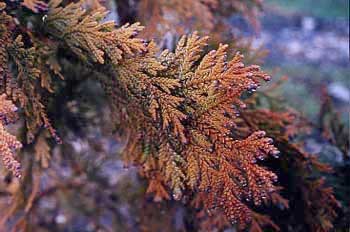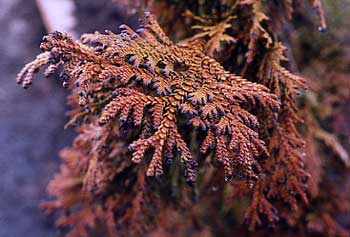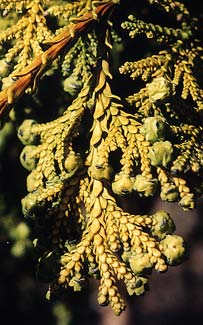 Japanese Elkhorn Cypress
Japanese Elkhorn Cypress
"No man manages his affairs as well as a tree does."
-George Bernard Shaw
(1856-1950)
(1856-1950)
Thujopsis dolobrata, the Japanese Elkhorn Cypress, is sometimes called Deerhorn Cedar, or Hiba False Arborvitae. It's neither a cypress nor a cedar, & it's not an arborvitae either, but it has enough overlapping characteristics to have all these common names.
The trunk has attractive vertically furrowed red bark. Ours has the most marvelous fanning limb structure & needle coloration. These two portraits were taken in February when our elkhorn was most strongly in its winter colors of bronzy reds, oranges & green, with the added extra delight of those bright blue tips of all the fans. In late spring & summer, it turns back to a "normal" green. The needles give the impression of being braided cloth & are smooth to the touch.
Not all specimens are reported to have quite such remarkable seasonal color changes. For this reason it is best to select this tree in late autumn or early winter when the degree of coloration can be assessed.
 In spring when it begins to turn green & yellow-green, it produces many small hard round cones at the ends of the branches. In the first two photos you can see blue-tips on the fanning branches, & in the third photo taken in mid-June with the spring/summer colors showing, you can see the the cones having have become half-inch fruits that are bright green with a few blue spots. By autumn the cones are brown & ready to open their scales to drop seeds or be harvested by squirrels & birds.
In spring when it begins to turn green & yellow-green, it produces many small hard round cones at the ends of the branches. In the first two photos you can see blue-tips on the fanning branches, & in the third photo taken in mid-June with the spring/summer colors showing, you can see the the cones having have become half-inch fruits that are bright green with a few blue spots. By autumn the cones are brown & ready to open their scales to drop seeds or be harvested by squirrels & birds.To do well, elkhorn cypress needs a moist environment, as it comes from a region of heavy rainfall. It dislikes windy areas, being easily subject to wind-burn. As with most rainy-weather plants, it wants acidic soil. It will not often thrive in hotter climates. Some folks have suggested the elkhorn cypress can be a little demanding, though ours thus far hasn't seemed to be, perhaps because Northwest weather on the Kitsap Penninsula isn't too awfully different from its native habitat.
 This tree is not very often offered & appears to be in limited commercial cultivation, perhaps because too few growers have the perfect situation to produce them in number. It is one of the select few conifer trees that do well in a considerable amount of shade, having evolved under almost continual cloud cover.
This tree is not very often offered & appears to be in limited commercial cultivation, perhaps because too few growers have the perfect situation to produce them in number. It is one of the select few conifer trees that do well in a considerable amount of shade, having evolved under almost continual cloud cover. As a mature yard tree it is rarely over 40 to 60 feet tall, though in its native Japan it reaches 100 feet tall. Growing a foot a year is about maximum. If someone did worry it might get too big for the yard (even if it took forever), it's height is easily restrained by candling the leader or by careful pruning. When they are encountered in yards, they often look like large multi-trunked shrubs, but ours has just one trunk. There is also a dwarf cultivar which tends to be cylindrical & flat on top, requiring no pruning to remain small.
Ours is only about seven feet tall (as of Autumn 2002) & we will not be restraining its height, as there's nothing above it but open sky. We love its present shrub-size, but will be happier still to watch it getting big. The only training or restraining we are doing is to tie back limbs in such a way that it will not spread into the alley, as we have planted it at the edge of our property so must train the limbs to grow sideways in a narrow space. Someday when it is big it can be partially underlimbed to keep the alley clear, while its upper limbs can finally be allowed to spread in all directions to form the conical structure it naturally seeks. But for now, instead of its usual densely foliaged pyramid shape, our baby elkhorn has a somewhat twisted appearance & almost looks like a crippled angel flapping bent wings out from its sides.